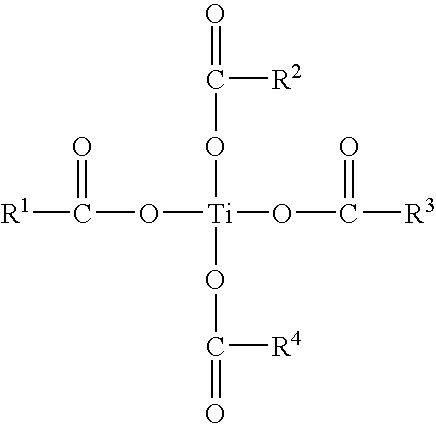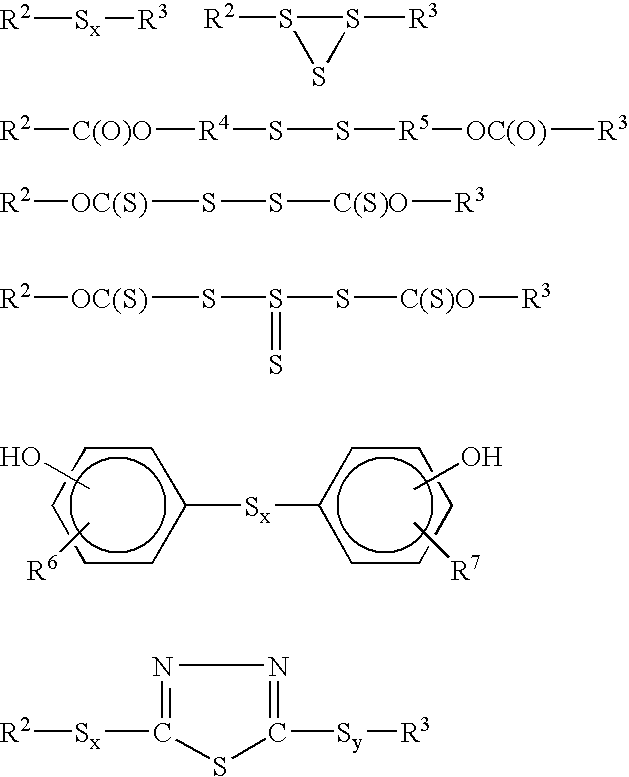Additives and lubricant formulations for improved antiwear properties
a technology of additives and lubricants, applied in the direction of auxilaria, machines/engines, mechanical equipment, etc., can solve the problems of poisoning or otherwise and achieve the effect of reducing the effectiveness of pollution control devices and reducing contamination of more stringent pollution control devices
- Summary
- Abstract
- Description
- Claims
- Application Information
AI Technical Summary
Benefits of technology
Problems solved by technology
Method used
Image
Examples
example 1
Synthesis of Titanium Neodecanoate
[0040]Neodecanoic acid (about 600 grams) was placed into a reaction vessel equipped with a condenser, Dean-Stark trap, thermometer, thermocouple, and a gas inlet. Nitrogen gas was bubbled into the acid. Titanium isopropoxide (about 245 grams) was slowly added to the reaction vessel with vigorous stirring. The reactants were heated to about 140° C. and stirred for one hour. Overheads and condensate from the reaction were collected in the trap. A subatmospheric pressure was applied to the reaction vessel and the reactants were stirred for about an additional two hours until the reaction was complete. Analysis of the product indicated that the product had a kinematic viscosity of about 14.3 cSt at about 100° C. and a titanium content of about 6.4 percent by weight.
example 2
Synthesis of Titanium Oleate
[0041]Oleic acid (about 489 grams) was placed into a reaction vessel equipped with a condenser, Dean-Stark trap, thermometer, thermocouple, and a gas inlet. Nitrogen gas was bubbled into the acid. Titanium isopropoxide (about 122.7 grams) was slowly added to the reaction vessel with vigorous stirring. The reactants were heated to about 140° C. and stirred for one hour. Overheads and condensate from the reaction were collected in the trap. A subatmospheric pressure was applied to the reaction vessel and the reactants were stirred for about an additional two hours until the reaction was complete. Analysis of the product indicated that the product had a kinematic viscosity of about 7.0 cSt at about 100° C. and a titanium content of about 3.8 percent by weight.
[0042]The hydrocarbon soluble titanium compounds of the embodiments described herein are advantageously incorporated into lubricating compositions. Accordingly, the hydrocarbon soluble titanium compound...
example
[0087]Four fully formulated lubricant compositions containing conventional additives were made with and without the magnesium, metal-free friction modifier, and / or titanium additives described above. Each of the lubricant compositions contained a conventional DI package providing about 9 percent by weight of the lubricant composition. The DI package contained conventional amounts of dispersants, antiwear additives, antifoam agents, and antioxidants as provided in Table 1 below. The conventional additives are typically blended into the base oil in an amount that enables that additive to provide its desired function. Representative effective amounts of the conventional additives, when used in crankcase lubricants with the titanium compound, metal-free friction modifier, and / or magnesium components, are listed in Table 1 below. All the values listed are stated as weight percent active ingredient.
TABLE 1Conventional AdditivesWt. %Wt. %Component(Broad)(Typical)Dispersant0.5–5.0 1.0–4.5A...
PUM
| Property | Measurement | Unit |
|---|---|---|
| temperatures | aaaaa | aaaaa |
| lubricating viscosity | aaaaa | aaaaa |
| weight | aaaaa | aaaaa |
Abstract
Description
Claims
Application Information
 Login to View More
Login to View More - R&D
- Intellectual Property
- Life Sciences
- Materials
- Tech Scout
- Unparalleled Data Quality
- Higher Quality Content
- 60% Fewer Hallucinations
Browse by: Latest US Patents, China's latest patents, Technical Efficacy Thesaurus, Application Domain, Technology Topic, Popular Technical Reports.
© 2025 PatSnap. All rights reserved.Legal|Privacy policy|Modern Slavery Act Transparency Statement|Sitemap|About US| Contact US: help@patsnap.com



